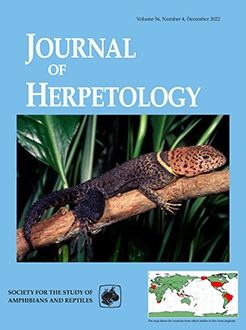Eastern Box Turtle (Terrapene carolina) populations have declined drastically since 1970 because of continued destruction and fragmentation of their habitat. Although they are known to shift their home ranges because of environmental degradation, it is unknown how solar arrays impact Eastern Box Turtles. From 2011–2018, we collected data on Eastern Box Turtle movement and occupancy in a 79-ha solar farm. The solar farm is divided into six fenced areas, each containing wildlife openings for movement of terrestrial fauna every 23 m around the fenced solar arrays. We hypothesized that the solar arrays changed the home range sizes of turtles that interacted with the field. We fitted 41 Eastern Box Turtles with radio transmitters and tracked their locations twice per week in June–August from 2011–2018. Seventeen turtles had home ranges that overlapped with the solar arrays whereas 24 turtles had home ranges that never interacted with the solar arrays. We calculated home range sizes and tested for differences between overlapping and nonoverlapping groups. We further considered if the number of observations within the solar farm impacted home range size and displacement. We found that Eastern Box Turtles that used the solar farm exhibited 55–83% larger home ranges on average than turtles in natural habitats, but there was no significant association of home range size with the amount of time observed within the solar farm. Finally, we discuss strategies to mitigate negative impacts of solar farm development on turtles.
BioOne.org will be down briefly for maintenance on 17 December 2024 between 18:00-22:00 Pacific Time US. We apologize for any inconvenience.
How to translate text using browser tools
10 March 2023
Solar Farm Development Impacts on Eastern Box Turtle (Terrapene carolina) Home Ranges
Ryan P. Dougherty,
Jennifer Higbie,
Timothy Green,
A. Z. Andis Arietta
ACCESS THE FULL ARTICLE

Journal of Herpetology
Vol. 57 • No. 1
March 2023
Vol. 57 • No. 1
March 2023




